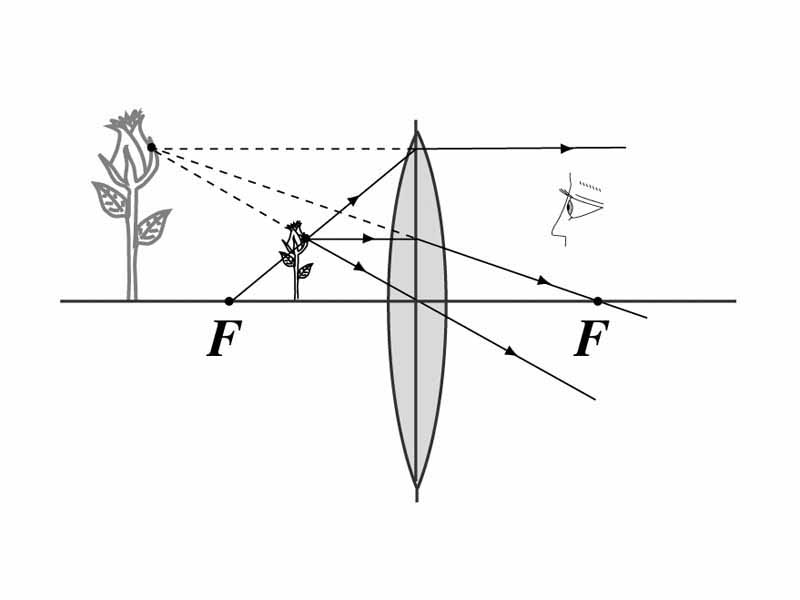Geometric optics is the branch of optics relying on a description of light propagating as rays. Optical devices constructed using the principles of geometric optics include mirrors and lenses which respectively utilize reflection or refraction to create an image of an object. Such optical devices have extensive medical and scientific research application. Additionally, the principles of geometric optics are extremely helpful for understanding how image formation occurs in the human eye. Questions related to geometric optics are long-standing favorites of MCAT writers.
WikiPremed Resources
Geometric Optics Cards
Conceptual Vocabulary Self-Test
Basic Terms Crossword Puzzle
Basic Puzzle Solution
Conceptual Vocabulary for Geometric Optics
Geometric Optics
Optics is a branch of physics that describes the behavior and properties of light and the interaction of light with matter.
A ray is an idealized narrow beam of light.
A lens is an optical device with perfect or approximate axial symmetry which transmits and refracts light, concentrating or diverging the beam.
Ray tracing is a general technique from geometrical optics of modeling the path taken by light by following rays of light as they interact with optical surfaces.
A real image is a representation of an actual object formed by rays of light passing through the image.
A virtual image is an image in which the outgoing rays from a point on the object never actually intersect at a point.
The focal length of an optical system is a measure of how strongly it converges or diverges light.
The field of view is the angular extent of the observable world that is seen at any given moment.
A simple or singlet lens consists of a single uncomplicated element. Examples include a magnifying glass or a lens in a pair of simple reading glasses.
Magnification is the process of enlarging something only in appearance, not in physical size.
A thin lens is a lens with a thicknessthat is negligible compared to the focal length of the lens.
A telescope is an instrument designed for the observation of remote objects and the collection of electromagnetic radiation.
A diopter is a unit of measurement of the optical power of a lens or curved mirror, which is equal to the reciprocal of the focal length measured in meters.
Also known as hypermetropia, farsightedness or longsightedness, hyperopia is a defect of vision caused by an imperfection in the eye causing inability to focus on near objects.
Also called near- or short-sightedness, myopia is a refractive defect of the eye with image focus in front of the retina when accommodation is relaxed.
Presbyopia is the eye's diminished ability to focus that occurs with aging.
A refracting or refractor telescope is a dioptric telescope that uses a lens as its objective to form an image.
Spherical aberration produces an image imperfection due to the increased refraction of light rays that occurs when rays strike a lens near its edge or reflection when rays strike a mirror near its edge.
Angular size is a measurement of how large or small something is using rotational measurement which is useful for measuring things so far away that they appear two-dimensional.
Aberration in optical systems occurs when light from one point of an object after transmission through the system does not converge into or diverge from a single point.
Optical power is equal to the reciprocal of the focal length of an optical device.
An objective in optics is the lens or mirror in a microscope, telescope, camera or other optical instrument that receives the first light rays from the object being observed.
Chromatic aberration is caused by a lens having a different refractive index for different wavelengths of light.
A corrective lens is a lens worn on or before the eye, used to treat myopia, hyperopia, astigmatism, and presbyopia.
The f-number of an optical system expresses the diameter of the entrance pupil in terms of the effective focal length of the lens.
The optical microscope, often referred to as a light microscope, is a type of microscope which uses visible light and a system of lenses to magnify images of small samples.
The numerical aperture of an optical system is a dimensionless number that characterizes the range of angles over which the system can accept or emit light.
The cardinal points are a set of special points in an optical system which help in the analysis of its paraxial properties.
An aspheric lens is a lens whose surfaces have a profile that is neither a portion of a sphere nor of a circular cylinder.
Gradient index optics is the branch of optics covering optical effects produced by a gradual variation of the refractive index of a material.
The paraxial approximation is an approximation used in ray tracing of light through an optical system which treats a ray as parallel and close to the axis throughout the system.
An achromatic lens is a lens that is designed to limit the effects of chromatic and spherical aberration.
A circle of confusion is an optical spot caused by a cone of light rays from a lens not coming to a perfect focus when imaging a point source.
A specialized type of lens which has a conical surface, an axicon images a point source into a line along the optic axis, or transforms a collimated laser beam into a ring.
The Abbe number, also known as the V-number or constringence of a transparent material, is a measure of the material's dispersion.
An apochromatic lens is a photographic or other lens that has better color correction than the much more common achromat lenses.


